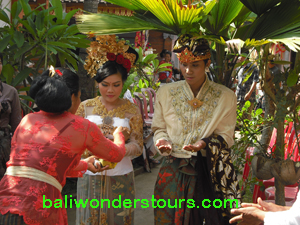Wedding in Bali with Balinese Way
1 April 2012The pawiwahan (marriage, weddings of a Hindu couple) is a very important part of Balinese social life. The ritual generally takes place in the home of the groom, a further confirmation of the typical patriarchal inclinations of Balinese culture, and is performed by a priest. The newlyweds to be dressed in very colorful and refined garments, worn only for the day of the wedding, will withdraw in prayer in the family temple. This is followed by the presentation of offerings in the pelinggih and by a series of ritual gestures. A very typical moment in the ceremony occurs when the bride offers the groom several different beverages: a conventional way to reiterate that the woman, as a wife, commits herself to obeying her husband and to lovingly care for him for the rest of their lives.
 Many Balinese marriages are still prearranged or negotiated, though young men may also “kidnap” their wives, and mixed-caste marriages are increasingly common. Marriage customs differ from caste to caste and village to village, but all Balinese marriage practices share fundamental similarities. There are basically two ways to get married on Bali, ‘ngerorod’ and ‘mapadik’.
Many Balinese marriages are still prearranged or negotiated, though young men may also “kidnap” their wives, and mixed-caste marriages are increasingly common. Marriage customs differ from caste to caste and village to village, but all Balinese marriage practices share fundamental similarities. There are basically two ways to get married on Bali, ‘ngerorod’ and ‘mapadik’.
Ngerorod
This is marriage by elopement, inwhich the prearranged honeymoon precedes the wedding ceremony. Since it’s otherwise quite expensive to marry on Bali, ‘ngerorod’ is becoming more and more popular. It has particular appeal to the Balinese sense of theater. Balinese love a spectacular kidnapping in which friends of the suitor capture a woman in the fields, on the road, or down by the river. Theatrics are paramount: she is expected to bite and kick her abductors in mock self-defense.
These days it’s more stylish and fashionable for the woman to be whisked away in a hired sedan, and more often than not she goes willingly. The couple then repairs to a friend’s house stocked with provisions, offerings, and the bride’s wardrobe. The woman’s infuriated father sounds the alarm demanding to know what has become of his daughter. A search party is organized which eventually returns unsuccessful and exhausted. Meanwhile, the couple is consummating the marriage before special offerings (sesayut tabuh rah) have the time to wilt. These offerings alone make the marriage binding by customary law. Emissaries of the groom visit the bride’s father to argue the advantages of the union. Begrudgingly, the girl’s father gives in, after a suitable bride price has been agreed upon. The groom’s father must finance and conduct the marriage ceremony, we!coming the bride as a new daughter into the family. The actual public wedding, within 42 days of the staged kidnapping, is only an official confirmation of their union. They are already married in the eyes of the gods.
Mepadik
This is marriage by consent, in which an upper-class couple conducts a formal courtship. Since daughters were once regarded as property useful for attaining a family’s social and political goals, high-caste families tried to wed a son to the daughter of a friend or relative so a blood bond would unite the resources of both families.
Under no circumstances may a woman “marry down,” i.e., take a commoner. The preferred marriage is through a parallel patri-cousin, the father’s brother’s daughter. It has been noted that Triwangsa couples often get along so well because they are all first cousins. Traditionally, the man or his father journeys three times to the bride’s house with food and ‘sirih’. When the bride’s family visits, the groom’s father is obliged to give them food, ‘sirih’ is chewed (an ancient, ritualistic means of coming to agreement), and presents are exchanged. The groom then regularly visits the home of his prospective bride, presenting gifts and performing services for his future father-in-law.
The groom’s family arranges and pays for the wedding; the date set well in advance on a propitious day. Wedding guests are often entertained by professional storytellers and musicians. Enormously detailed rules govern dining and seating arrangements. Sometimes the bride’s family is not even invited.
The actual ceremony varies. It could be very simple and short, presided over by a common temple pemangku’, or it may be elaborate, expensive, and go on all day. Both the bride and groom dress in bright ‘songket’, with brocades of gold thread, and the woman’s hair is decorated with glittering gold flowers. Usually the bride and groom offer food to one another, then simulate such domestic duties such as washing, cooking rice, and cutting bamboo. Prayers are intoned, and then the couple eats together in public, feeding each other. This is an important symbolic act, as in former times only married men and women were allowed to eat food together in public. The priest then performs a ritual purification and blesses the couple. Neither rice nor flowers are thrown. Today there could very well be a Western-style buffet reception held afterward where speeches are offered by members of the two families.
Bali Best Quote
Why rent a car in Bali?
- Bali Car Rental Self drive with wide range of well maintained fleet
- Rent a car with Bali tour driver
- Bali Car charter, price already included car, Bali tour driver and petrol. Our tour driver will be happy to drive for you as per your own itinerary in Bali Island.


| For mor information please feel free to contact Rent Car Bali.net | |
| Hotline | local 085737187321 |
| overseas: +62 85737187321 | |
| 6285737187321 | |















